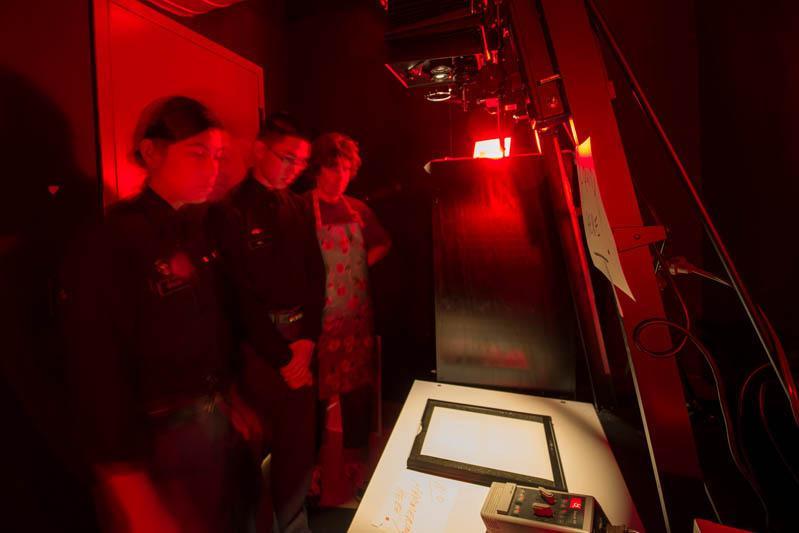2016-2017 | ‘Marshall’s Greatness for All to Understand’
Cadets Learn to 'See in Different Ways'

Conquest Visiting Chair Claudia Smigrod shows cadets Angelique Barlow ’17 and Albert Wu ’17 how to print a positive image from a negative using an enlarger in the darkroom located in Preston Library. – Photo courtesy of Albert Wu ’17.
LEXINGTON, Va., March 7, 2017 – Two new photography courses being taught this spring in the Department of English, Rhetoric, and Humanistic Studies are exposing cadets to one of the youngest of the visual arts.
Claudia Smigrod, a 34-year veteran of the Corcoran College of Art and Design, is teaching Visual Arts Studio/Light Studies and Optical Culture, along with Graphic: The Identification, Ethics, and Creation of Iconic Photographic Images. Smigrod holds the Edwin P. Conquest ’14 Chair within the department, which was established in 1971 for visiting scholars in the humanities.
Between them, the two photography courses enroll 23 cadets, all raised in the era of digital images and smartphone cameras, yet each is learning the roots of photography by developing film in a darkroom. Prior to this course, Smigrod noted, only one cadet had even used a film camera.
Smigrod described the design of the Visual Arts Studio course as “a hybrid of working in the wet darkroom and working digitally.”
To help her cadets understand the fundamental principles of photography, Smigrod had them make their own pinhole cameras using empty paint cans. They then developed their images in VMI’s seldom-used darkroom, located in the basement of Preston Library. Doing this, Smigrod explained, helps new photographers better understand the roles of light and exposure.
“It’s important to be knowledgeable in your field, so you know the historical precedents,” she commented. “Working with film is so beautiful. Working in the digital arena should not come at the cost of the analog arena. They both should be able to coexist.”
The one cadet who’d used a film camera before, Albert Wu ’17, said that a chance to learn more about film was part of what drew him to the class. “I breathe digital photography,” said Wu. “It’s an old thing for me. Film is something I’m familiar with, but I’m not an expert on.”
Wu has been taking pictures since he was 14 years old and came to VMI with a professional-level camera, which he used at the inauguration of President Donald Trump to take photos that were later posted on the Institute’s social media. A civil engineering major, he signed up for the photography course to fulfill a humanities requirement—and the chance to learn from an expert. “I’m excited to see what techniques I can pick up,” Wu said.
In Smigrod’s other class, the one focusing on iconic images, cadets are learning why certain images, such as Joe Rosenthal’s photograph of U.S. Marines raising the American flag on Iwo Jima during World War II, become so incredibly powerful and well-known. What’s more, they will attempt to create their own iconic images via assignments such as a self-portrait and a photographic documentary of a road trip, whether real or imagined. As Smigrod explained, “The images we’re making now are the future iconic images.”
Smigrod is also taking time in the iconic images course to discuss the ethics of photography, such as at what point, if ever, should a photographer move from objective bystander to active participant in the scene he or she is shooting.
“I just want to shake up their brains,” she said. “I want them to think about things that they haven’t thought to think about yet.”
The freedom to explore and create in a new medium attracted Hayley Freeman ’17 to the iconic images class. “For the iconic photographs, it’s your definition of what that is,” she noted.
After just two weeks of classes, Freeman found herself appreciating Smigrod’s teaching style, which includes giving cadets wide latitude in their assignments.
“When she gives you an assignment … she lets you be free and do what you want to do,” she explained. “For here, that’s different. It’s usually very strict. I love that aspect. When we get to working with the film cameras, I’m really excited to have the free range to do whatever.”
Like Freeman, Smigrod has found herself adjusting to a new environment. Coming to VMI from Corcoran, she’s discovered that cadets approach the visual arts very differently than did the art school students she taught for decades. “[Cadets] don’t have a lot of art baggage, but they don’t have an art vocabulary,” she noted. To remedy the latter situation, Smigrod takes time to introduce artistic concepts such as positive and negative space.
The visual arts, she believes, have a critically important role to play in a liberal arts education. “Art has such a great impact on our life every moment,” Smigrod stated. “If someone helps us realize that we have the capacity to see in different ways, and to appreciate us who have come before, we are more educated.”
- Mary Price
-VMI-
.svg)
.png)